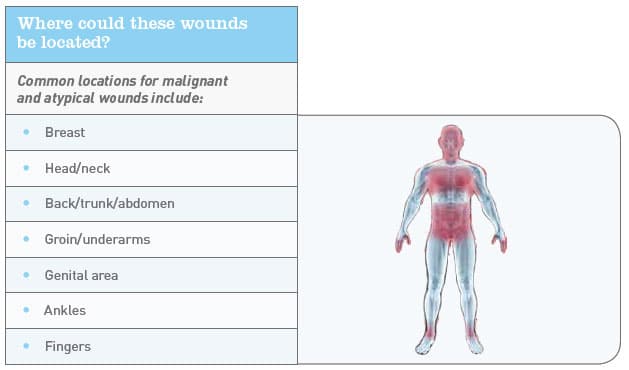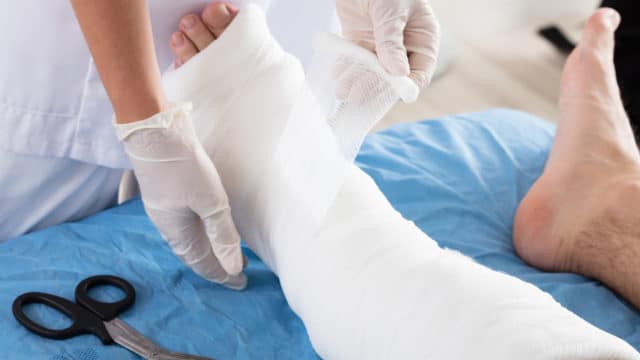Malignant and Atypical Wounds
Malignant and atypical wounds affect thousands of patients each year, but with proper diagnosis and treatment, these conditions are manageable. While these wounds present unique challenges, understanding your condition and working with experienced wound care specialists can significantly improve your quality of life and treatment outcomes.
If you’ve been diagnosed with a malignant or atypical wound, you’re not alone. Our wound care experts at Healogics specialize in treating these complex conditions with compassion, expertise, and the latest treatment approaches. This guide will help you understand your condition and what to expect during treatment.
What is a malignant wound?
Malignant wounds occur when cancer cells invade the skin’s surface, creating an open wound. These wounds develop through a combination of processes, including new blood vessel formation, tissue death, and inflammation. This leads to symptoms that can significantly impact your daily life, including pain, bleeding, odor, and drainage.
Malignant wounds can develop from:
- Primary skin cancers (originating in the skin)
- Metastatic cancers (cancer that has spread to the skin from other organs)
- Transformation of chronic wounds (such as long-standing burns, radiation injuries, or venous ulcers)
What is an atypical wound?
Up to 10% of chronic wounds don’t fit into common categories like diabetic, venous, or arterial wounds. These are called atypical wounds, and while they may be puzzling initially, they are very treatable with the right approach.
Common Causes of Atypical Wounds:
- Autoimmune diseases (such as rheumatoid arthritis or lupus)
- Inflammatory conditions
- Infections (bacterial, fungal, or viral)
- Allergic reactions
- Blood vessel disorders
- Certain medications
- Rare skin conditions
How are these wounds diagnosed?
- Your doctor will review your medical, family and social histories.
- Your doctor will complete a physical exam.
- Your doctor will examine your wound.
- Your doctor will ask you about hobbies, recreational activity, vacations, and exposure to harmful substances.
Your doctor may send you to get tests that might include:
- Tissue biopsy
- Blood tests
- X-ray
- CT scan
- MRI
Please remember to bring copies of any recent tests you may have gotten.
What are some signs and symptoms of malignant and atypical wounds?
- A wound that does not heal as expected
- A wound that rapidly increases in size
- A wound with edges that roll under
- A wound in an odd location
- A wound that looks odd
- Swelling around the wound
- Swelling in the arm or leg where the wound is located

How are these malignant and atypical wounds treated?
These wounds are treated based on the kind of wound and what the wound looks like. The wound may be wet or dry. It may have an odor. It could be in an odd location. You may have a disease that affects how the wound is treated. Your wound care physician may use some or all of the following:
- Removal of dead tissue
- Surgery
- Chemotherapy
- Radiation
- Dressings that control odor
- Antibiotics
- Dressings or medicines to control bleeding, pain, or itching
- Pain
- Bleeding
Living with Malignant and Atypical Wounds
Quality of Life Considerations: These wounds can significantly impact daily life, but there are many ways to maintain comfort and dignity:
Practical Daily Management:
- Comfortable clothing that accommodates dressings
- Planning activities around dressing change schedules
- Managing pain and discomfort effectively
- Maintaining social connections and activities when possible
- Proper nutrition to support healing and overall health
Emotional Support:
- Counseling services for patients and families
- Support groups for people with similar conditions
- Resources for coping with chronic conditions
- Communication strategies for discussing your condition with others
Family and Caregiver Support: Your loved ones play a crucial role in your care:
- Education about your condition and treatment
- Training in wound care techniques when appropriate
- Emotional support resources
- Respite care options when needed
Frequently Asked Questions
Are malignant wounds curable?
Treatment goals for malignant wounds often focus on symptom management and quality of life rather than cure. However, some malignant wounds can improve significantly with proper treatment, especially when the underlying cancer responds to treatment.
Can atypical wounds heal completely?
Yes, many atypical wounds can heal completely with proper diagnosis and treatment. The key is identifying and treating the underlying cause while providing appropriate wound care.
How long does treatment take?
Treatment duration varies greatly depending on the type of wound, underlying conditions, and individual factors. Your wound care specialist will discuss realistic timelines based on your specific situation.
Will I need to be hospitalized?
Most wound care can be provided in outpatient settings. Hospitalization may be needed for certain procedures or if complications develop.
How can I manage pain at home?
Your healthcare team will provide a comprehensive pain management plan that may include medications, positioning techniques, and timing strategies for dressing changes.
What should I do if my wound gets worse?
Contact your wound care team immediately if you notice increased pain, bleeding, drainage, odor, or signs of infection. Don’t wait for your next scheduled appointment.
Can I still work or maintain normal activities?
Many patients can continue working and participating in activities with some modifications. Your healthcare team will help you develop strategies to maintain your quality of life.
Expert Care at Healogics
At Healogics, our board-certified wound care specialists have extensive experience treating malignant and atypical wounds. We understand the unique challenges these conditions present and are committed to providing compassionate, expert care tailored to your individual needs.
Ready to Start Your Healing Journey? Contact Healogics today to schedule a consultation with one of our wound care specialists. We’re here to help you understand your condition, explore treatment options, and support you every step of the way. Find a Wound Care Center® near you.




